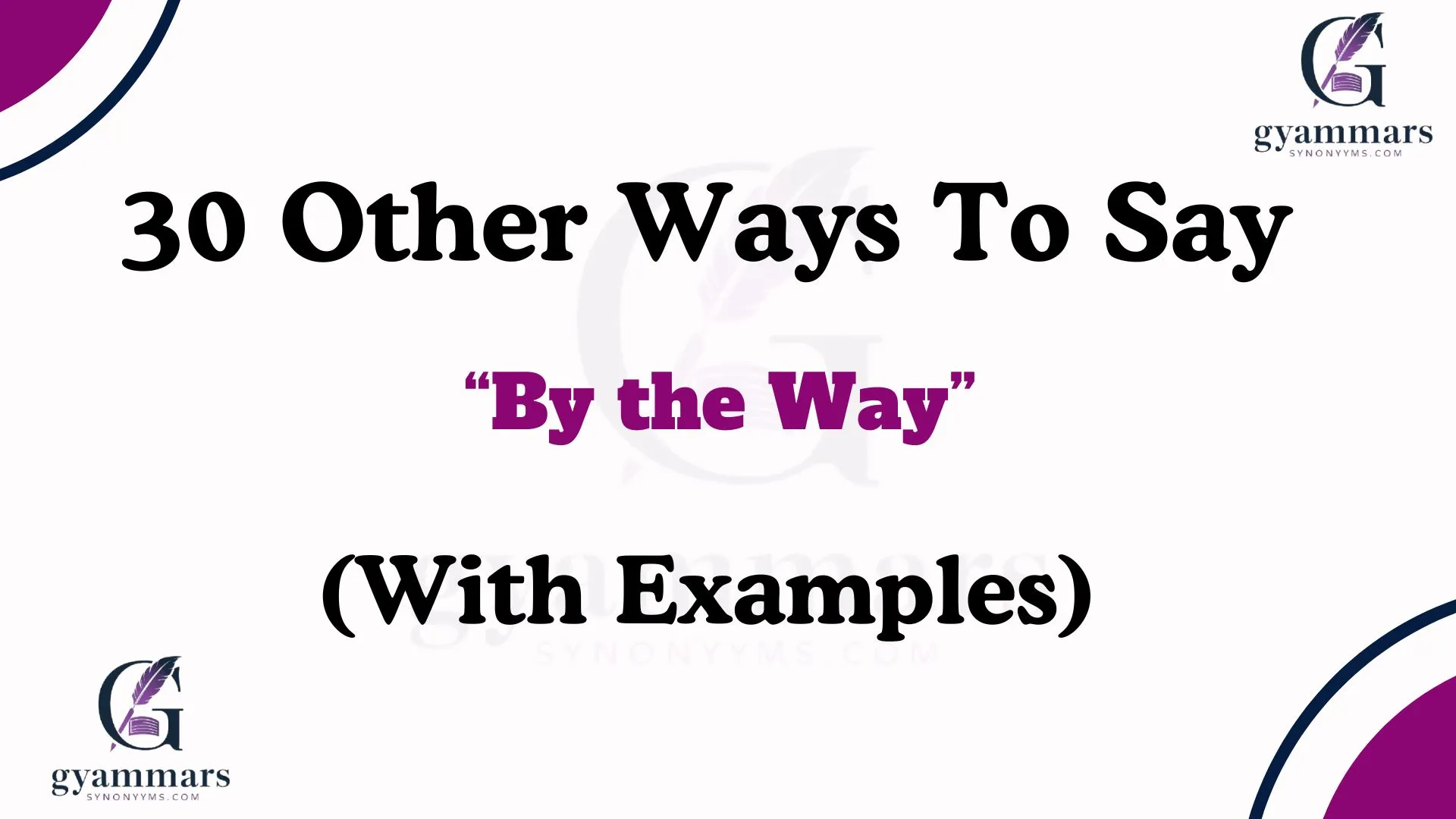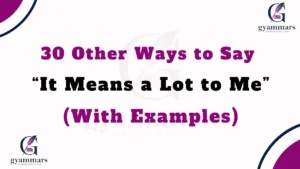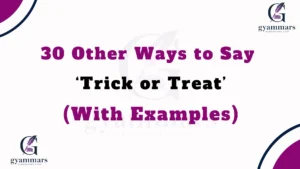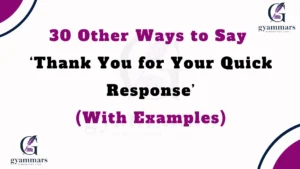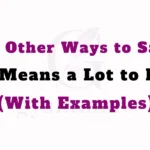Finding the right words can transform a simple message into something warm, caring, and personal. Whether you’re adding a gentle remark, shifting topics smoothly, or making a casual statement, how you phrase it makes a difference. This article provides 30 thoughtful alternatives to “by the way,” helping you communicate with more warmth, professionalism, and intent.
What Does “By the Way” Mean?
Before diving into alternatives, let’s understand what “by the way” really means. This phrase is often used as a conversational segue, introducing a new point or adding additional information to a discussion. It can be casual and light, but when you need a more thoughtful expression, there are other options to consider.
Is It Professional/Polite to Say “By the Way”?
“By the way” is a casual phrase that’s often used in informal conversations. While it’s fine to use among friends, colleagues, or in relaxed settings, it might not always be the best choice in professional or formal situations. Depending on your audience, you may want to replace it with more polished alternatives to maintain professionalism.
Pros and Cons of Using “By the Way”
Pros:
- Smoothly introduces extra information.
- Keeps conversations light and engaging.
- Works well in casual speech and writing.
Cons:
- May seem too informal in professional settings.
- Can feel abrupt or offhand if not used carefully.
- Lacks warmth when discussing sensitive topics.
Synonyms For “By the Way”
- Incidentally
- Speaking of which
- On a different note
- Just so you know
- As a side note
- Before I forget
- That reminds me
- While we’re on the subject
- Come to think of it
- In case you didn’t know
- Not to change the subject, but
- Oh, and another thing
- Just to mention
- If I may add
- For what it’s worth
- I should also mention
- Let me add this
- By the way, just a quick note
- On another note
- Another thing to keep in mind
- This may be unrelated, but
- A quick side note
- Just a quick thought
- While I remember
- As a little extra detail
- To add to that
- You might find this interesting
- A little fun fact
- Before I wrap up
- Not to derail the conversation, but
1. Incidentally
Definition:
A word used to introduce a relevant but secondary comment.
Detailed Explanation:
This alternative keeps the flow smooth while adding a new point. It sounds sophisticated but not too formal.
Scenario Example:
“We were talking about Italy. Incidentally, did you know I studied there?”
Best Use:
Perfect for professional conversations or when making a refined point.
Tone:
Neutral, polished, professional.
Additional Notes:
A great choice when you want to sound thoughtful and articulate.
2. Speaking of Which
Definition:
A phrase used when linking a new point to something just mentioned.
Detailed Explanation:
This makes a natural transition, especially when the new information relates directly to the last topic.
Scenario Example:
“I love jazz music. Speaking of which, have you heard the new Miles Davis album?”
Best Use:
Best for friendly or engaging conversations.
Tone:
Warm, conversational, engaging.
Additional Notes:
Works well when keeping the conversation flowing.
3. On a Different Note
Definition:
A polite way to shift the topic completely.
Detailed Explanation:
It signals a clear transition while keeping the shift smooth and intentional.
Scenario Example:
“The meeting went great today. On a different note, have you planned your vacation?”
Best Use:
Great for business or personal conversations that require a topic change.
Tone:
Neutral, respectful, polished.
Additional Notes:
A thoughtful alternative when moving to a new subject.
4. Just So You Know
Definition:
A way to introduce information you think is important.
Detailed Explanation:
This phrase conveys that the speaker wants to keep the listener informed about something relevant.
Scenario Example:
“Just so you know, the deadline was extended to next Friday.”
Best Use:
Good for important updates without sounding too formal.
Tone:
Casual, warm, direct.
Additional Notes:
Be mindful of tone—it can sound caring or slightly dismissive, depending on how it’s used.
5. As a Side Note
Definition:
A phrase used to introduce an extra comment that isn’t the main focus.
Detailed Explanation:
This alternative softens the transition, making it feel natural and polite. It signals that the added information isn’t critical but still worth mentioning.
Scenario Example:
“The presentation went really well. As a side note, the client loved your idea.”
Best Use:
Great for casual and professional settings when you want to add an extra thought.
Tone:
Polished, friendly, neutral.
Additional Notes:
More formal than “by the way,” making it a better choice in business emails or meetings.
6. Before I Forget
Definition:
A phrase used when bringing up something before it slips your mind.
Detailed Explanation:
This alternative adds urgency while keeping the tone friendly and informal.
Scenario Example:
“Before I forget, Sarah asked me to remind you about the meeting tomorrow.”
Best Use:
Best for casual and workplace conversations when reminding someone of something.
Tone:
Warm, engaging, slightly informal.
Additional Notes:
Perfect for when you want to sound thoughtful and considerate.
7. That Reminds Me
Definition:
A phrase used when something sparks another thought or memory.
Detailed Explanation:
This creates a natural connection between topics, making conversations feel fluid and engaging.
Scenario Example:
“I saw a dog that looked just like yours today. That reminds me, how’s Buddy doing?”
Best Use:
Ideal for friendly conversations or storytelling moments.
Tone:
Conversational, warm, friendly.
Additional Notes:
Great for making a conversation feel natural and flowing.
8. While We’re on the Subject
Definition:
A phrase used when you want to stay on the current topic but add more details.
Detailed Explanation:
This alternative signals that your comment is related to what was just discussed.
Scenario Example:
“While we’re on the subject of vacations, have you decided where to go yet?”
Best Use:
Best for smooth transitions in discussions.
Tone:
Engaging, structured, polite.
Additional Notes:
A great way to make your contributions feel relevant without disrupting the conversation.
9. Come to Think of It
Definition:
A phrase used when realizing something mid-conversation.
Detailed Explanation:
This makes the speaker seem thoughtful and naturally introduces an extra detail.
Scenario Example:
“I haven’t seen Mike in weeks. Come to think of it, his birthday is next week!”
Best Use:
Great for casual conversations when making a connection.
Tone:
Casual, reflective, conversational.
Additional Notes:
Perfect when sharing an afterthought in a friendly way.
10. In Case You Didn’t Know
Definition:
A phrase used to share useful or surprising information.
Detailed Explanation:
This can sound informative or slightly cheeky, depending on the context.
Scenario Example:
“In case you didn’t know, our company is launching a new app next month.”
Best Use:
Great for sharing facts or reminders in an engaging way.
Tone:
Neutral, informative, casual.
Additional Notes:
Be mindful—it can sound condescending if not used carefully.
11. Not to Change the Subject, But…
Definition:
A phrase used to signal a topic shift while maintaining a polite tone.
Detailed Explanation:
This acknowledges that you’re steering the conversation in a different direction, making the transition smoother.
Scenario Example:
“Not to change the subject, but did you hear about the new project we’re working on?”
Best Use:
Ideal for business discussions or social settings where a transition needs to be graceful.
Tone:
Polite, professional, conversational.
Additional Notes:
A good option when you want to introduce new information without disrupting the flow.
12. Oh, and Another Thing…
Definition:
A casual phrase used to add an extra piece of information.
Detailed Explanation:
This keeps conversations light and informal, making it sound natural and engaging.
Scenario Example:
“Oh, and another thing—I saw your favorite band is coming to town next month!”
Best Use:
Great for friendly conversations or when you remember something last minute.
Tone:
Casual, engaging, friendly.
Additional Notes:
It works well in spoken conversations but might feel too informal for emails or work settings.
13. Just to Mention…
Definition:
A phrase used to briefly bring up a point without making it a big deal.
Detailed Explanation:
This keeps things concise while still sharing useful or relevant details.
Scenario Example:
“Just to mention, the deadline has been extended by a week.”
Best Use:
Ideal for quick updates in both casual and professional conversations.
Tone:
Neutral, professional, direct.
Additional Notes:
Useful in emails, meetings, and reminders.
14. If I May Add…
Definition:
A polite way to introduce an extra thought or detail.
Detailed Explanation:
This phrase is formal and respectful, often used in business discussions or debates.
Scenario Example:
“If I may add, I think Sarah’s idea could work well with this strategy.”
Best Use:
Best for meetings, discussions, and professional exchanges.
Tone:
Formal, respectful, polished.
Additional Notes:
Perfect when you want to contribute without interrupting.
15. For What It’s Worth…
Definition:
A phrase used when giving a piece of advice or opinion that may or may not be useful.
Detailed Explanation:
This makes your statement sound humble, as if you’re offering a perspective without insisting.
Scenario Example:
“For what it’s worth, I think you should take the job offer—it sounds perfect for you.”
Best Use:
Ideal for sharing advice or personal opinions in a non-forceful way.
Tone:
Supportive, casual, conversational.
Additional Notes:
Best used when you want to sound considerate and non-pushy.
16. I Should Also Mention…
Definition:
A phrase used to introduce extra details that may be important.
Detailed Explanation:
This sounds thoughtful and intentional, ensuring the listener knows the detail is worth noting.
Scenario Example:
“I should also mention that the report needs to be submitted by Friday.”
Best Use:
Great for meetings, emails, and formal settings.
Tone:
Professional, polished, direct.
Additional Notes:
Works well when you want to sound responsible and thorough.
17. Let Me Add This…
Definition:
A phrase used to slip in additional information smoothly.
Detailed Explanation:
This keeps the flow of conversation natural while adding a relevant point.
Scenario Example:
“Let me add this—our competitors have already started using this approach successfully.”
Best Use:
Best for business discussions, presentations, and debates.
Tone:
Polite, professional, engaging.
Additional Notes:
Helps strengthen arguments or provide extra insight.
18. By the Way, Just a Quick Note…
Definition:
A casual way to introduce a short side comment.
Detailed Explanation:
This makes your point brief and non-disruptive.
Scenario Example:
“By the way, just a quick note—Lisa said she might be late to the meeting.”
Best Use:
Perfect for emails, text messages, or spoken reminders.
Tone:
Casual, lighthearted, friendly.
Additional Notes:
Works well when you need to keep things brief.
19. On Another Note…
Definition:
A phrase used to introduce a different but relevant topic.
Detailed Explanation:
This is a smooth transition when shifting topics without being abrupt.
Scenario Example:
“On another note, did you hear that our office is getting renovated next month?”
Best Use:
Perfect for meetings, casual conversations, and emails.
Tone:
Neutral, professional, conversational.
Additional Notes:
Great when you need a subtle transition.
20. Another Thing to Keep in Mind…
Definition:
A phrase used to introduce an important detail or reminder.
Detailed Explanation:
This ensures the listener understands that the information is useful or necessary.
Scenario Example:
“Another thing to keep in mind—the client prefers weekly updates instead of bi-weekly.”
Best Use:
Best for reminders and professional settings.
Tone:
Informative, professional, thoughtful.
Additional Notes:
Works well for project updates and strategic discussions.
21. This May Be Unrelated, But…
Definition:
A phrase used to introduce something that may not directly relate to the current topic.
Detailed Explanation:
This lets the listener know that your comment is a slight detour but still worth mentioning.
Scenario Example:
“This may be unrelated, but have you tried that new restaurant downtown?”
Best Use:
Perfect for lighthearted conversations or when you want to introduce a new subject gently.
Tone:
Casual, lighthearted, conversational.
Additional Notes:
Use when you don’t want to sound abrupt.
22. A Quick Side Note…
Definition:
A phrase used to introduce a small but relevant detail.
Detailed Explanation:
This phrase keeps things brief and signals that the information isn’t the main focus.
Scenario Example:
“A quick side note—don’t forget to submit your reports by noon tomorrow.”
Best Use:
Best for casual conversations and work emails.
Tone:
Professional, casual, concise.
Additional Notes:
Useful when you need to add something quickly without derailing the discussion.
23. Just a Quick Thought…
Definition:
A phrase used to share a brief idea or comment.
Detailed Explanation:
This phrase makes your contribution sound light and optional.
Scenario Example:
“Just a quick thought—maybe we should reschedule the meeting to next week?”
Best Use:
Great for brainstorming sessions or giving input without pressure.
Tone:
Casual, open-ended, thoughtful.
Additional Notes:
Works well when suggesting an idea without forcing a decision.
24. While I Remember…
Definition:
A phrase used to introduce something before you forget.
Detailed Explanation:
This helps smoothly insert a new point while keeping the conversation natural.
Scenario Example:
“While I remember, I need to return your book next week.”
Best Use:
Best for casual conversations and quick reminders.
Tone:
Friendly, conversational, informal.
Additional Notes:
Use when you want to casually remind someone of something.
25. As a Little Extra Detail…
Definition:
A phrase used to provide additional relevant information.
Detailed Explanation:
This ensures the listener understands that your comment adds value to the discussion.
Scenario Example:
“As a little extra detail, our competitors are also launching a similar product next month.”
Best Use:
Ideal for business conversations, emails, and research discussions.
Tone:
Professional, informative, supportive.
Additional Notes:
Great for providing context or background information.
26. To Add to That…
Definition:
A phrase used to build on a previous point.
Detailed Explanation:
This signals that your comment supports or expands on what was just said.
Scenario Example:
“To add to that, I think we should also consider increasing our social media presence.”
Best Use:
Perfect for group discussions, meetings, and presentations.
Tone:
Professional, engaging, thoughtful.
Additional Notes:
Great when you want to contribute without interrupting the flow.
27. You Might Find This Interesting…
Definition:
A phrase used to introduce a fact or piece of information that may intrigue the listener.
Detailed Explanation:
This makes your comment sound engaging and relevant.
Scenario Example:
“You might find this interesting—our competitors have reduced their pricing by 20%.”
Best Use:
Great for presentations, casual chats, and knowledge-sharing.
Tone:
Intriguing, engaging, conversational.
Additional Notes:
Useful when you want to capture someone’s attention.
28. A Little Fun Fact…
Definition:
A phrase used to introduce an amusing or surprising fact.
Detailed Explanation:
This adds lightness and interest to a conversation.
Scenario Example:
“A little fun fact—honey never spoils, and archaeologists have found jars from ancient Egypt that are still edible!”
Best Use:
Best for casual conversations, trivia, and engaging discussions.
Tone:
Playful, curious, lighthearted.
Additional Notes:
Works well in social gatherings and friendly chats.
29. Before I Wrap Up…
Definition:
A phrase used to introduce a final thought before finishing a conversation or presentation.
Detailed Explanation:
This phrase signals you’re about to conclude but want to mention something first.
Scenario Example:
“Before I wrap up, just a quick reminder—our next meeting is scheduled for Monday.”
Best Use:
Ideal for meetings, presentations, and discussions.
Tone:
Professional, organized, polished.
Additional Notes:
Helps ensure important points aren’t forgotten before ending.
30. Not to Derail the Conversation, But…
Definition:
A phrase used to introduce a new topic while acknowledging the shift.
Detailed Explanation:
This softens the transition and makes the topic change less abrupt.
Scenario Example:
“Not to derail the conversation, but did you see the latest team announcement?”
Best Use:
Perfect for casual and work-related discussions.
Tone:
Friendly, respectful, conversational.
Additional Notes:
Use when you want to change the topic without sounding rude.
FAQs
1. What is the best alternative to “by the way” in formal writing?
The best alternatives for formal writing include:
- “Incidentally”
- “If I may add”
- “Before I wrap up”
- “To add to that”
These sound polished and fit emails, reports, and professional discussions.
2. Can I use “by the way” in professional emails?
Yes, but it’s better to use more polished alternatives like:
- “Just to mention”
- “I should also add”
- “Another thing to keep in mind”
These sound more thoughtful and refined.
3. What’s a casual alternative to “by the way”?
For friendly or informal conversations, try:
- “Oh, and another thing…”
- “That reminds me…”
- “Speaking of which…”
- “Just so you know…”
These keep your tone light and engaging.
4. What’s a professional way to change the subject smoothly?
Use transitions that acknowledge the topic shift:
- “On another note…”
- “Before we move on…”
- “This may be unrelated, but…”
- “Not to change the subject, but…”
These sound natural while keeping the conversation flowing.
5. Is “by the way” considered rude?
Not necessarily, but it can sound abrupt or unpolished in formal settings.
If you want to soften your message, try:
- “A quick side note…”
- “To add to that…”
- “Just a quick thought…”

“Mia Rose at Grammar Synonyms is your ultimate guide to mastering language with style and precision. Whether you’re looking to enhance your vocabulary, perfect your grammar, or discover the ideal synonym, Mia Rose offers expert resources and creative solutions to help you express yourself flawlessly. With Grammar Synonyms, unlock a world of language possibilities and elevate every piece of writing you create.
